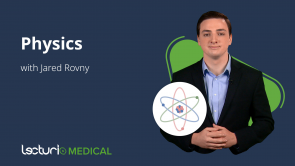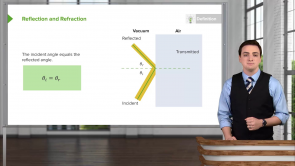Diffraction

Über den Vortrag
Der Vortrag „Diffraction“ von Jared Rovny, PhD ist Bestandteil des Kurses „Year I (Ethiopia National Curriculum)“.
Quiz zum Vortrag
Why does light not appear to diffract when it passes through a small hole created on a screen?
- The wavelength of the light is much smaller than the diameter of the hole.
- The light passing from the edge of the hole diffracts but not the middle.
- The hole needs to be larger for light to diffract through it.
- Diffraction of light depends on the shape of the hole. For circular holes it is less likely to occur.
- Many holes need to be created on the screen for diffraction to happen.
Which of the following is an application of diffraction gratings?
- Splitting light into its component wavelengths
- Focusing light into a stronger beam
- Raising light to a higher frequency
- Dropping light to a lower frequency
- Increasing the wavelength of light
Why is it useful to send x-rays through materials?
- The wavelength of X-rays is comparable to the distance between molecules hence diffraction happens. The diffraction patterns carry information regarding the structure of the material.
- The wavelength of X-rays is much larger than the distance between molecules so that they reflect off the molecules in a way that shows the structure of those molecules.
- X-rays are very energetic so that the material absorbs and emits them at lower frequencies which show the structure of the material.
- X-rays can be absorbed by the nucleus of the atoms of the material, exciting the nucleus. The emitted light from the nucleus contains information regarding the nuclear structure of the material.
- X-rays can move unchanged through dense material so that the shadow left on the other side of the material reveals the molecular structure
Which of the following is the best explanation of why diffraction occurs?
- Each point on a wavefront of light can be considered as a source of spherical waves of light
- When light arrives at a small hole, attraction between the corner of the hole and the light pulls the light towards the corner
- When light arrives at an opening, it acts as a particle and bounces off each side of the opening
- When large wavelengths hit a small opening, only part of the wave can go through, causing it to bend towards the longer side of the wave
- When light reaches a small opening, the only way for light to fill in the space beyond the opening is to form spherical waves
Diese Kurse könnten Sie interessieren
Kundenrezensionen
5,0 von 5 Sternen
| 5 Sterne |
|
5 |
| 4 Sterne |
|
0 |
| 3 Sterne |
|
0 |
| 2 Sterne |
|
0 |
| 1 Stern |
|
0 |








